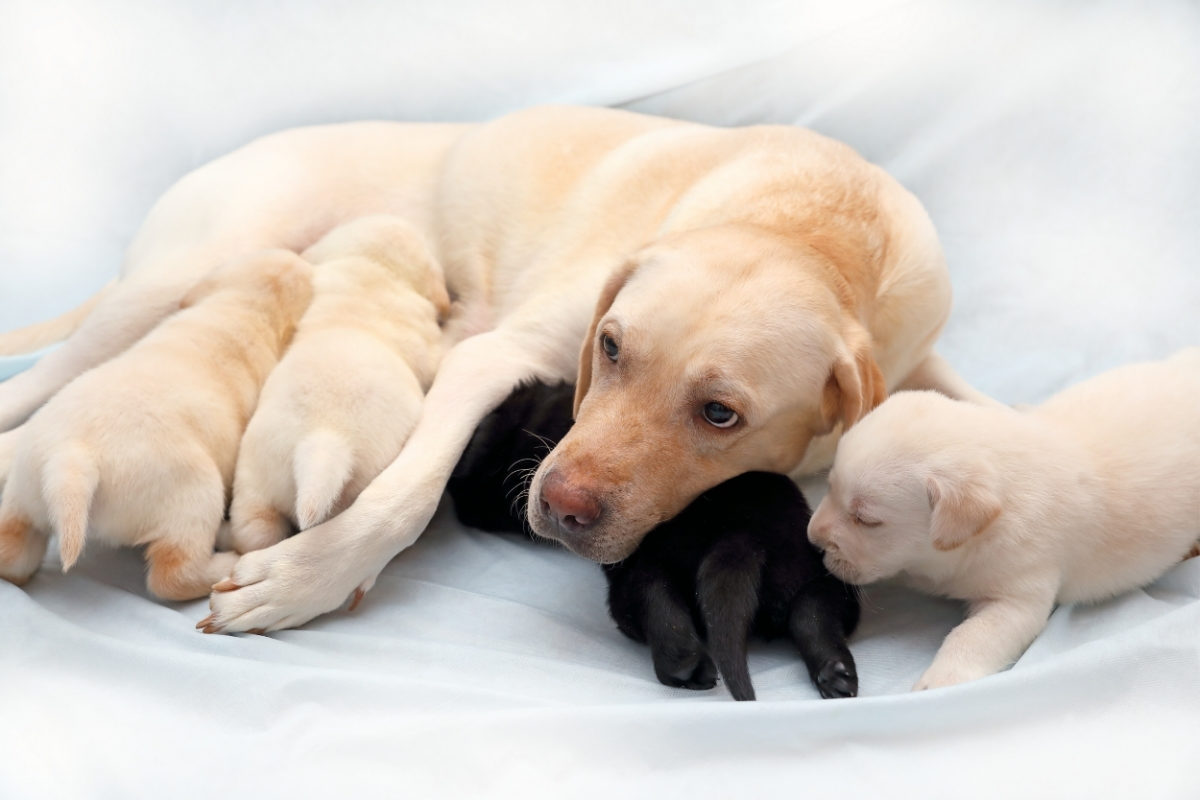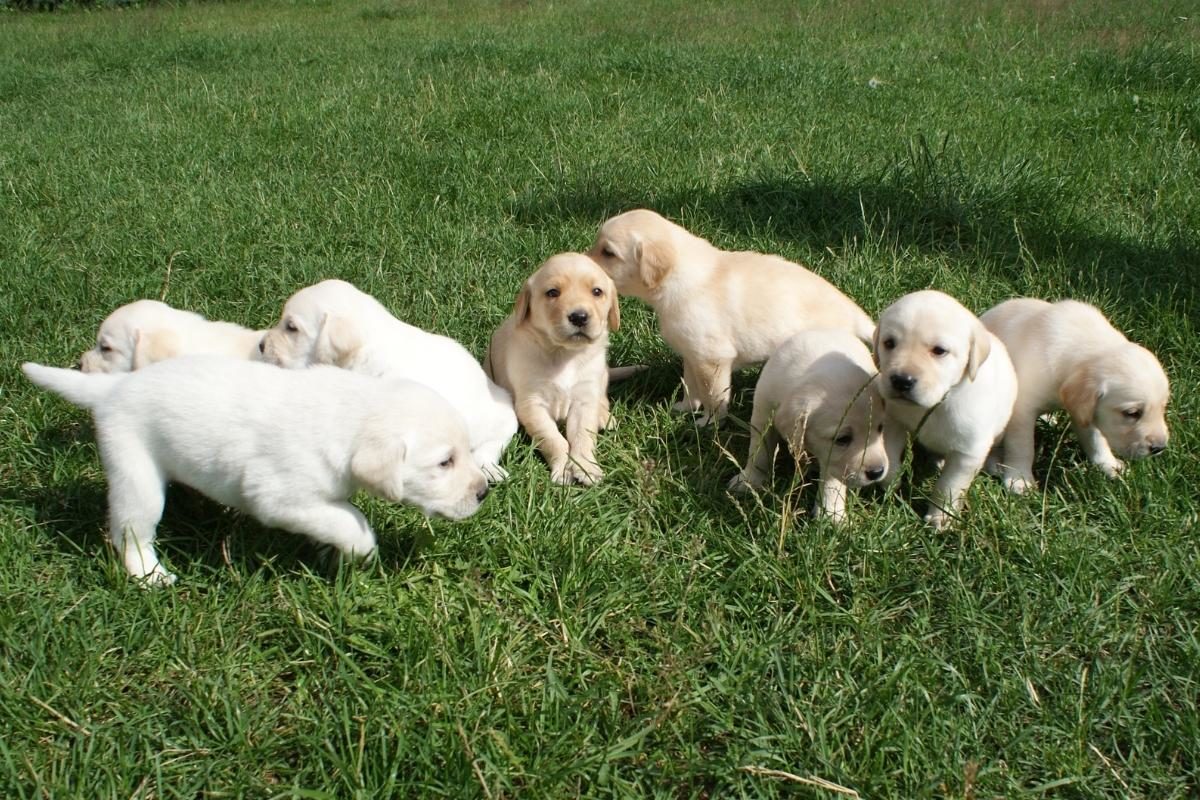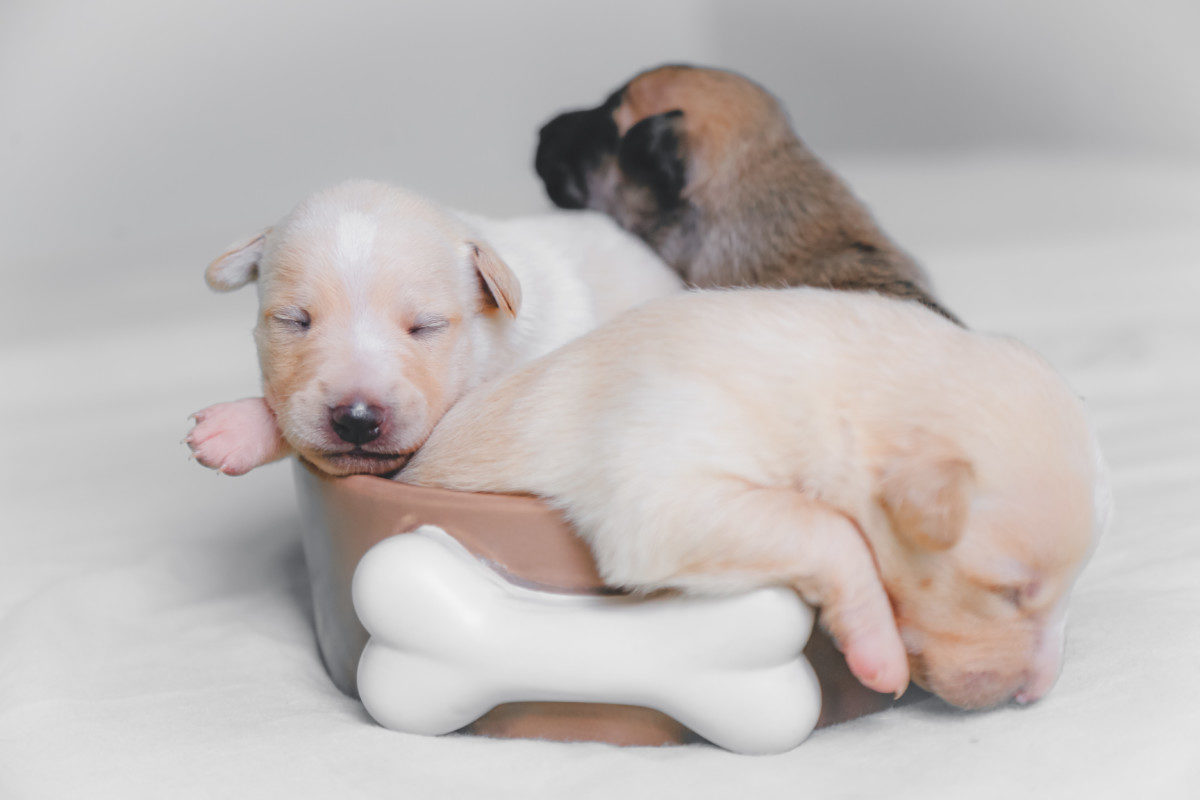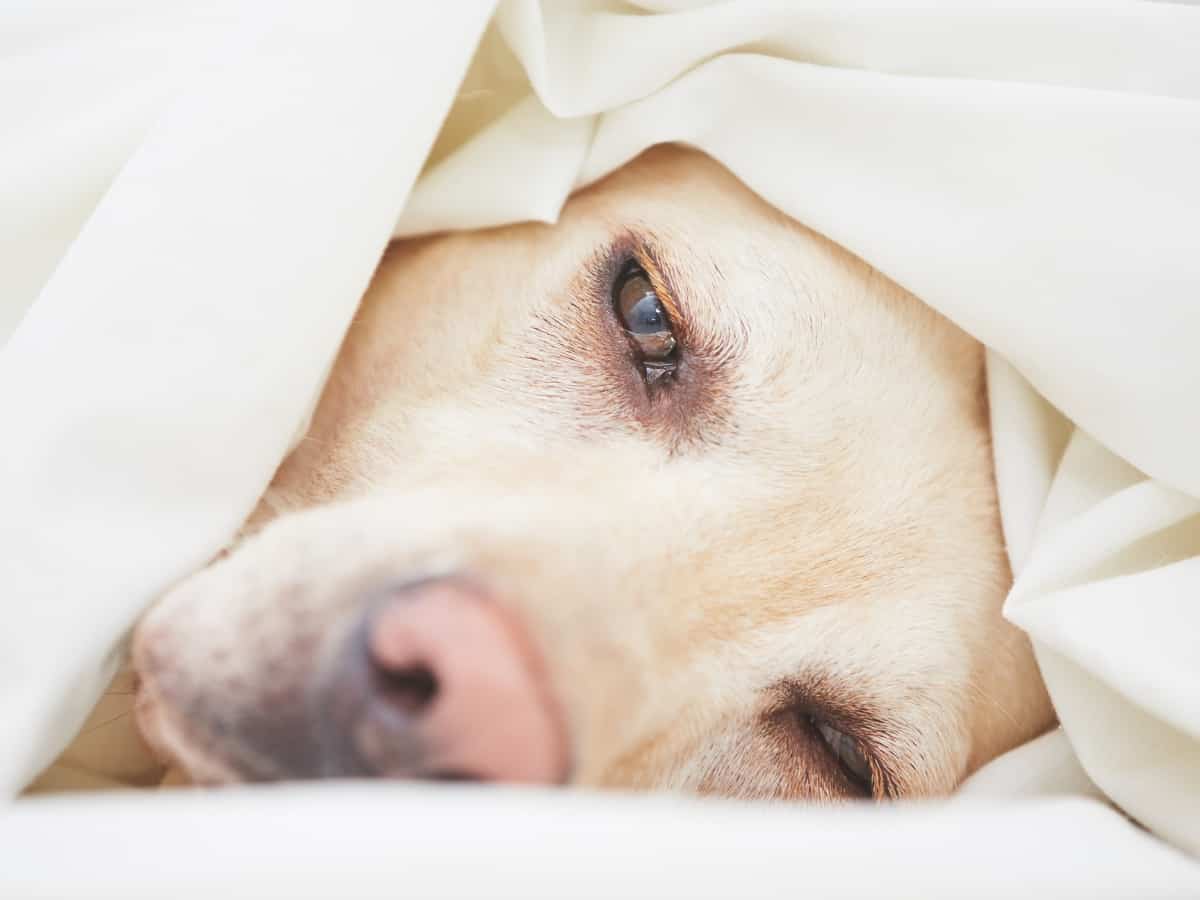Helping your Labrador give birth is an incredible, exciting, and rewarding experience while also slightly nerve-wracking!
If you wonder what you should do when your Lab gives birth to her pups, there are plenty of ways to help your dog. So, here’s what to do!
To help your Labrador give birth, ensure you are prepared by talking to your vet first and obtaining the necessary birthing supplies. Provide a clean and comfortable environment for your dog, such as a whelping box, and give her space, but be ready to intervene if necessary.
It may surprise some, but Labrador Retrievers and most breeds are self-sufficient during birth. That doesn’t mean you won’t play any role! A vital part of the process is knowing when she needs you versus when you need to let her do her thing.
While you may not be an expert on helping your Labrador give birth, the following information will give you an idea of what you should do and what to expect.
You’ll learn:
- Essential Preparations for Your Labrador’s Birth: A detailed checklist of necessary supplies to ensure you’re fully prepared.
- Navigating the Birthing Process: Step-by-step guidance on what to do during your Labrador’s labor.
- Understanding the Duration: Insights into how long the birthing process typically takes for a Labrador.
- Anticipating the Litter Size: What to expect regarding puppy count, especially for a first-time Labrador mother.
- Crafting a Post-Pregnancy Care Plan: Strategies for effectively managing your Labrador’s health and well-being after giving birth.
Let’s get started!

How to Prepare for Your Labrador Giving Birth
Labrador Retrievers are truly great pets, and preparation for your dog to give birth will be one of the most significant things you do for her throughout the birth process.
These are things that she can’t do herself but that she will be grateful for once the birth begins.
But first, take a look at this incredible video of a Labrador giving birth to her eight puppies. The owner added some fun captions to make it even more awesome.
Wow! Nature is truly amazing.
Even though your dog will be relatively undemanding when it comes to the actual birth, there are still loads of things you will need to do to get her ready, including preparing where she will be giving birth.
Consult Your Vet
To ensure your Labrador is as successful as possible during birth, make sure to have frequent discussions with your vet.
In any case, once you suspect your dog is pregnant, you must take her for regular check-ups. Ensuring her overall health is the important first step.
Your vet will thoroughly examine your dog and inform you of anything you should know. As with human pregnancies, health concerns are elevated during gestation.
Be sure to take your mom-to-be to the vet if you have any concerns and continue to monitor her throughout the pregnancy.
Ask your vet any questions you may have about how to care for your Labrador during the coming weeks and the birth itself. Your vet can give you valuable input and help you plan for the birth.
Ensure your dog has a healthy diet, along with the appropriate exercise, and do everything you can to ensure she stays healthy throughout the pregnancy. Good nutrition is the key:
During the first two trimesters of the pregnancy, your Labrador’s nutritional requirements will be essentially the same. Make sure she doesn’t either lose weight or become overweight during this time.
The third trimester is when the pups develop rapidly, and your girl will need more calories for energy, depending on how many puppies she carries.
Your vet is the best person to advise you exactly what your dog needs at this stage in the pregnancy.
High-quality and highly digestible puppy food is generally recommended, but don’t feed a puppy any food intended for large breeds, as it will have the incorrect amounts of calcium and phosphorous needed for the developing fetuses.
Transition the food gradually and feed little and often. This ensures an adequate nutrient and calorie intake. Your vet may also recommend folic acid and essential fatty acid supplements.

Prepare a Checklist of Supplies
Below is a general checklist that will be useful to have handy for your pups’ birth. But if your vet specifies anything additional for your Labrador, always follow their instructions.
Having the checklist ready is an essential step to making sure you are ready! You don’t want to scramble at the last minute looking for clean blankets or a thermometer.
And remember, the checklist should include everything you may need before, during, and after the birth. It will also include emergency items you hopefully will not need but should have ready.
Standard Supplies:
- Clean sheets, towels, and blankets
You should have some blankets around the mom. They will help keep her warm and feeling safe and secure. If your Lab has a favorite blanket or an old shirt of yours that she loves to snuggle up with, use those.
You’ll also need additional towels and blankets ready for the little puppies after the birth. Making sure they are all warm and cozy will be your priority. A bunch of newborn Labrador puppies snuggled up to mom and surrounded by comfort blankets is really adorable.
- Heating Pad or Heat Lamp
Newborn puppies can’t regulate their body temperature. The new mama realizes this and will attempt to keep her pups warm using her body temperature by keeping them close.
But having a heating pad or lamp ready to go will help keep the room warm for the newborns.
If you opt for a heating pad, you can place it underneath the towels and blankets where the puppies are lying.
I like the RIOGOO Pet Heating Pad from Amazon as it has an auto power-off function and a temperature sensor to prevent overheating. This one also has thousands of positive reviews and comes with a removable cover for easy cleaning.
- Add custom text here
- Add custom text here
- Add custom text here
- Add custom text here
- Add custom text h
Prices pulled from the Amazon Product Advertising API on:
Product prices and availability are accurate as of the date/time indicated and are subject to change. Any price and availability information displayed on [relevant Amazon Site(s), as applicable] at the time of purchase will apply to the purchase of this product.
Note: Clicking the above link(s) will take you to Amazon or an online store where we have an affiliate relationship. If you make a purchase, we may earn a commission at no additional cost to you.
If you opt for a lamp, ensure it is far enough away so it’s not too hot to burn the puppies.
Place your hand underneath it to test where it gives a subtle warmth without causing your hand to feel hot. I prefer a heating pad as it just seems the safer option.
- Whelping Box and Mat
To prepare for whelping, a whelping box will be required. This is for the Labrador puppies to snuggle up after the birth while mom is recovering.
You can purchase a large basket or make a whelping box yourself using a large cardboard box. You should place it in a quiet room in the house.
The whelping box should be big enough for your dog to stretch out and comfortably turn around. It should be low enough for your Lab to step over but high enough so the newborn puppies can’t escape.
The recommended size for Labradors is 4 feet x 4 feet and 2 feet in height.
Your Lab will know when she is ready to nurse and cuddle, but when she’s not, the newborns need a warm, safe area to sleep and snuggle up with each other.
A whelping mat may not be necessary if you have sufficient towels and blankets, but it doesn’t hurt to have one around.
- Baby or Puppy Scale
It’s important throughout the puppies’ early stages that they are gaining weight at a healthy pace.
Various factors determine puppy weight at birth, such as the sex of the puppy, litter size, length of gestation, and the adult weight of the mom. From this study of 7827 Labrador puppies, the average puppy weight was 1.07 pounds (485g).
It’s wise to measure their weight early so that you can begin monitoring their growth journey.
There’s no need to take them directly from mom and plop them onto the scales immediately. Give them time. But be ready to take their weights within the first day or so.
The puppies’ birth weight is generally doubled after two weeks, and you should weigh the puppies daily for at least the first three weeks to help you identify any problems and seek advice from your vet if required.
- Digital Thermometer and Indoor/Outdoor Thermometer
You will need a digital thermometer to check your Lab’s temperature before and after pregnancy to ensure she is okay. You will also need to check the temperatures of the puppies if you believe one may be sick.
The indoor/outdoor thermometer will also ensure the room and, specifically, the whelping box area with the puppies is warm enough.
The area where the puppies are kept should be between 85-90 degrees for the first four days. Then, gradually decrease the temperature to 80 degrees by the 7th – 10th day, and finally, 72 degrees by the end of the fourth week.
Emergency Supplies:
- Baby Nose Suction Bulb
Sometimes, newborn puppies have built-up mucus around their nose, which causes trouble breathing.
The mom will try to lick it away as best she can, but if you see one of the Labrador puppies still struggling to breathe, make sure you have a baby nose suction bulb at the ready.
- NEWBORN ESSENTIALS: Dr. Talbots Nasal Aspirator for babies helps your little one breathe and sleep easier by gently relieving nasal congestion due to mucus build-up
- EASY TO USE: Simply squeeze the bulb portion of the nasal aspirator, then place the end gently against the nostril and slowly release the pressure on the nasal aspirator bulb
- SAFE NOSE CLEANER FOR BABY: Baby nasal aspirators are the recommended method to relieve nasal congestion from babys nose
- SAFE DESIGN: This 100% medical-grade silicone is BPA-free, phthalate-free, and latex-free; Dishwasher and steam sterilizer safe
- BABY TRAVEL ESSENTIAL: Includes a storage case that you can carry with you in case your little one needs a nasal cleaner when you are traveling
- BABY REGISTRY MUST HAVE: Includes one clear nasal aspirator for baby plus a clear storage c
Prices pulled from the Amazon Product Advertising API on:
Product prices and availability are accurate as of the date/time indicated and are subject to change. Any price and availability information displayed on [relevant Amazon Site(s), as applicable] at the time of purchase will apply to the purchase of this product.
Gently swathe the puppy and use the bulb carefully to suck out the mucus and massage his chest very gently, holding him for a while after.
- Gloves, Sterilized Scissors, Thread, and Antiseptic Solution
Generally, the mom will cut the umbilical cord herself by biting through it. But if she doesn’t, you will need to cut the cord using newly sterilized scissors about an inch from the newborn’s tummy.
You will then need to use the thread to tie off the cord about ½ inch from the belly.
Once tied off, ensure the end of the cord is cleaned with antiseptic. Cleanliness during this is critical, so wearing medical gloves and a clean workspace is essential.
- Soft Travel Crate
Hopefully, the birth goes smoothly, and there is no need to take your Labrador to the vet. But if there is an emergency or if you have any worries, always call your vet or nearest animal hospital immediately.
Have a soft travel crate by the door with plenty of cozy blankets ready to go in case you need to transport your Lab urgently.
I recommend you invest in a travel crate as part of your preparations. This premium soft dog crate is a great choice.
It’s specifically for large breeds such as the Labrador, scores high on comfort, comes in various colors, is reasonably priced, and has tons of positive reviews.
- Soft-sided dog crate for keeping a furry 4-legged friend safe and comfortable when traveling, includes a Small dog crate made of tan polyester fabric and a lightweight yet sturdy frame
- Sets up in seconds with no tools needed; folds flat for easy portability and compact storage;2 doors (top and front) for easy loading and unloading
- Secure zipper closures, plus fastening straps to keep unzipped rolled-up doors in place and out of the way; mesh windows and front door provide ventilation on all 4 sides
- Suitable for large breed dogs (70 pounds) like Boxers and German Shepherds; for use with crate-trained dogs only
- Product dimensions: 36 x 24 x 24 inches (LxW
Prices pulled from the Amazon Product Advertising API on:
Product prices and availability are accurate as of the date/time indicated and are subject to change. Any price and availability information displayed on [relevant Amazon Site(s), as applicable] at the time of purchase will apply to the purchase of this product.

Pro Tip! When taking your Labrador to the vet during labor, use the buddy system for support. Have a friend or relative drive so you can comfort your dog in the back seat, helping ease her anxiety during this stressful time.
Ensure the Environment is Clean and Comforting
You will have taken care of most of this during the preparation stage. You will have placed clean towels down, ensuring everything is sterilized and ready for the momentous occasion.
But during the birth itself, you should help maintain a clean and comfortable environment.
Here are a few things to consider that will help you make this a relaxed and comfy setting for your Labrador:
- Have familiar sights and smells around, such as her favorite soft clothing, blankets, and toys.
- Close windows to minimize loud noises and distractions.
- Don’t allow multiple people in the room unless she is 100% comfortable with them.
- Give occasional words of encouragement in a soft and soothing voice, letting her know she is doing great.
- In between puppies, she will need to rest. Make sure she is comfortable and supported.

What To Do When Your Labrador is Giving Birth
When your Labrador is giving birth, the best thing to do is give her space, as her instinct will take over.
Your dog will naturally know what to do during and after birth, so don’t interfere too much. However, be ready to help when needed, such as removing the puppies’ sacs or stimulating breathing.
Let’s look at what to do in more detail.
Giving Your Labrador Space During the Birth
Oddly enough, one of the best ways to care for your Labrador during her birth journey will be to leave her alone.
Animals are instinctual in ways that astound us as mere humans. Labradors are animals that are especially gifted in the “instinct” department.
Labs are also terribly smart. They have a knack for knowing what to do during and after giving birth with their instincts and intelligence. They know what is best for their health, as well as the health of their newborns.
Interfering too much during birth can cause frustration and even anger in your Labrador.
While she will most likely understand you are trying to help – she knows best and needs her space. The best thing you can do is sit back, relax, and enjoy the incredible experience of watching your dog give birth.
It’s amazing to see your Lab’s instincts take over and to watch her handle the birth and care for her pups afterward, even if this is her first litter.
Be Ready When She Needs You
Part of sitting back and watching as your Lab gives birth is knowing that you may be needed and, if so, be ready!
If you have prepared well, everything will be available in case of an emergency or even a small hiccup. Here are some warning signs as you watch the process and when you need to intervene:
- Your Labrador has shown signs of going into labor, including a temperature of 99° F from the usual 101 to 102° F, and does not end up going into labor within 24 hours. Other signs are restlessness, not eating, vomiting, pawing at her bedding as if making a nest, licking her vulva area, or releasing a clear, watery discharge.
- The first puppy should be delivered within 1 to 2 hours of the onset of contractions and pushing.
- A puppy has only come halfway out, and Mom seems to be struggling and cannot push anymore.
- She appears to be in pain and is yelping or crying.
- One of her breaks between puppies lasts more than 4 hours, and you know there are more pups to come. Typically, a long break will happen that can be up to 4 hours. But past that, there could be something wrong.
- She is having contractions and straining hard for more than 30 minutes without another puppy coming.
- Puppies are born with a thin membrane that needs to be removed to avoid suffocation. The mom will immediately do this, but if she doesn’t after a couple of minutes, you’ll need to intervene.
- As soon as the membrane is removed, the mom will lick the puppy, which stimulates breathing. If she doesn’t do this, rub the puppy gently with a towel until it starts to breathe.
- After each birth, the placenta (afterbirth) will follow. The mother may eat it, and this is perfectly normal. However, she shouldn’t eat more than a couple, so discard the others. Don’t lose count – if you’ve got more puppies than placentas, one is still inside, and if not expelled, it could cause a harmful infection.
- Be ready to cut the umbilical cord if mom doesn’t chew through it alone. This is discussed at the prep stage.
If any of these issues occur, or even if you sense that something isn’t quite right, immediately call your vet. Hopefully, it’s something the vet can quickly resolve over the phone.
However, if there is something more complicated, you will need to take your Lab to the vet. This will always be the last scenario because you don’t want to move your dog during birth.
How Long Does it Take a Labrador to Give Birth?
The gestation period in dogs is around 63 days or 9 weeks. This can vary by several days, but your vet will be able to predict more accurately how long your Lab’s pregnancy may be. But how long does the birth actually last?
It generally takes a Labrador between 3-12 hours to deliver her puppies, but it can take up to 24 hours. Puppies are usually born at intervals of 1 to 2 hours, but this can vary.
Before this, she may be in the 1st stage of labor, while her cervix dilates, between 12-24 hours.
Your dog may rest for 2 hours before the next delivery, sometimes extending to 4 hours. Sometimes, several puppies are born quickly. This process continues until all the puppies are born and each placenta is passed.
Stage 2 is known as the delivery of the puppies, and Stage 3 is the delivery of the placenta. Dogs typically alternate between stages 2 and 3 until delivery is complete. The placenta and the pup are not always delivered together.
How Many Puppies Can a Labrador Have the First Time?
If your Labrador is giving birth for the first time, you wonder how many puppies she can have.
A Labrador may have 5-10 puppies per litter – the average is 7 puppies for large breeds. However, the first litter is generally smaller.
Factors that determine litter size include time and method of conception (whether artificial insemination), the dam’s age, past pregnancies, health, and diet.
Check out these interesting facts about litter sizes:
- The average puppy count for large and giant breeds is seven per litter, according to this study of 224 breeds and 10,810 litters.
- Labradors are capable of having ten puppies.
- Dogs are most fertile 48 hours after ovulation because hormone levels are just right.
- Artificial insemination can result in fewer puppies due to how semen is preserved.
- Early adulthood is when Labradors are most likely to have a large litter.
- Every time your Lab gets pregnant, there’s a higher chance that she’ll have more pups.
- The age of the male sire can affect litter size, too. After five years, the sire’s sperm count and quality lessen.
The best way to know for sure and prepare correctly ahead of time is to have your vet perform an x-ray on your pregnant Lab’s tummy around two weeks before her due date.
Have a Plan for Post-Pregnancy
Your gorgeous Labrador has had her pups. Now what?
A big part of the preparation is ensuring everything is ready for the new mom and pups after the birth. She will be exhausted and need lots of rest and love.
And the newborn pups will be adorable helpless creatures that need their canine mom and their human mom or dad, too!
Your vet will offer specifics if there are precise health concerns for your Labrador. But otherwise, here are the general guidelines to keep the new family safe and sound:
- Once your Labrador has had sufficient time to recuperate, take her outside to urinate and get some fresh air.
- Encourage her to drink some water and see if she has an appetite. At this stage, all the puppies should be warm and snuggled in the whelping box. Let mom join them and begin nursing.
- Ensure the pups get enough food from mom and that she is getting enough rest to care for them properly.
- If your Labrador cannot produce milk for a while, you will need puppy milk formula to feed them yourself from a bottle.
Final Thoughts
Labradors are smart, instinctual, and amazingly affectionate. They also make awesome moms. And they know exactly what they need to do during the birth of their puppies.
I hope this guide has given you confidence in knowing what to do when your Labrador is giving birth. You will be your girl’s co-pilot, helping whenever you need to but letting her take the wheel to handle most of the work.
You will also know when you are needed, and you will have everything ready to go from your checklist if she tags you in!
Good luck, and you will soon be hugging those little balls of fluff!
This article is for educational and informational purposes only. It is not intended to constitute pet medical advice, diagnosis, or treatment for your pet. Please consult a licensed veterinarian in your area for pet medical advice.








